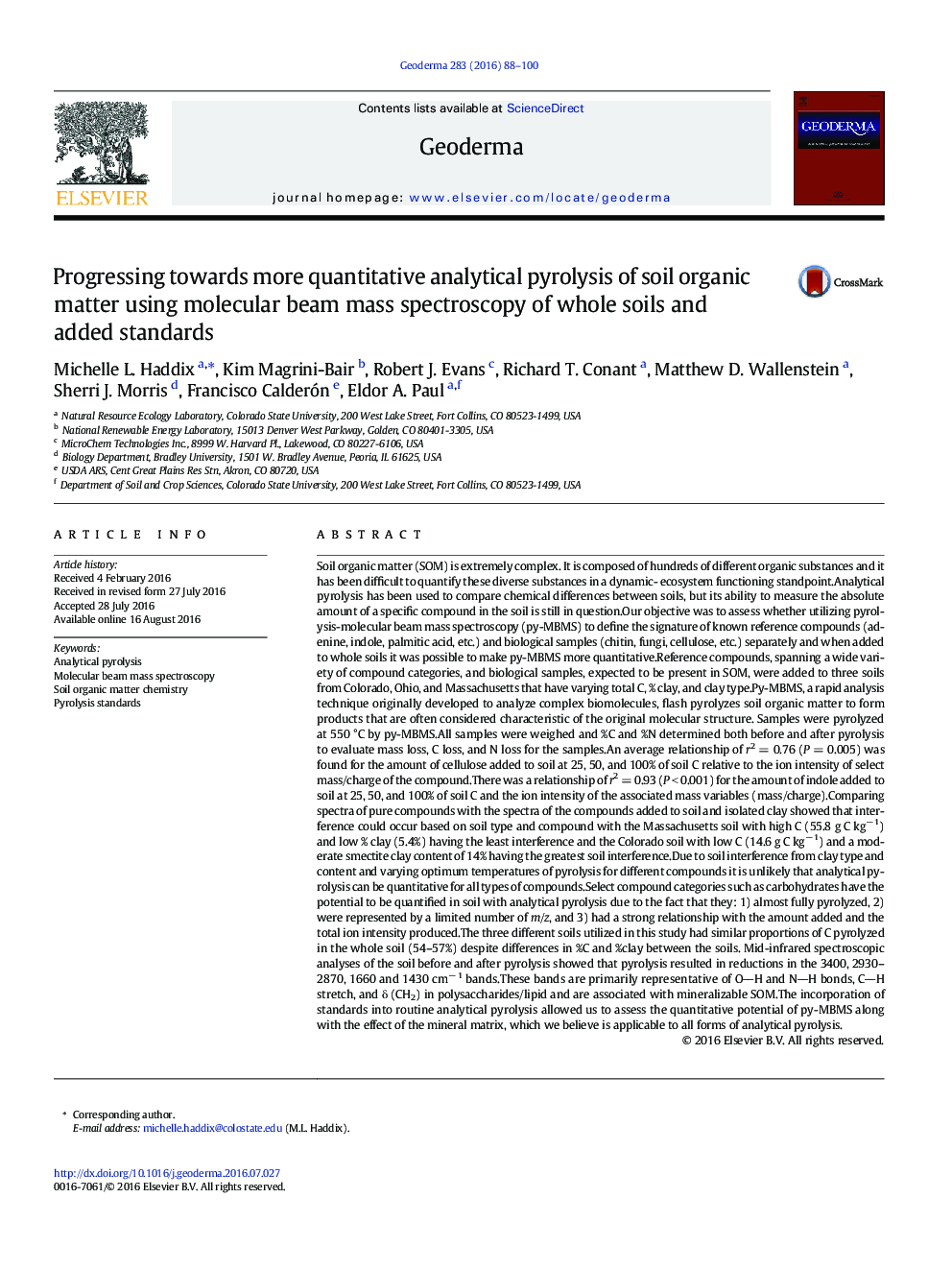| کد مقاله | کد نشریه | سال انتشار | مقاله انگلیسی | نسخه تمام متن |
|---|---|---|---|---|
| 4572853 | 1629434 | 2016 | 13 صفحه PDF | دانلود رایگان |
• Carbon standards added to soil and analyzed with py-MBMS.
• Relationship with amount of cellulose added to soil and ion intensity of select m/z.
• Over half of soil carbon was pyrolyzed.
• Whole soils and soil pyrolysis residue was analyzed with MIR.
• Residue has less OH and NH bonds, aliphatic CH and polysaccharides than bulk soil.
Soil organic matter (SOM) is extremely complex. It is composed of hundreds of different organic substances and it has been difficult to quantify these diverse substances in a dynamic- ecosystem functioning standpoint.Analytical pyrolysis has been used to compare chemical differences between soils, but its ability to measure the absolute amount of a specific compound in the soil is still in question.Our objective was to assess whether utilizing pyrolysis-molecular beam mass spectroscopy (py-MBMS) to define the signature of known reference compounds (adenine, indole, palmitic acid, etc.) and biological samples (chitin, fungi, cellulose, etc.) separately and when added to whole soils it was possible to make py-MBMS more quantitative.Reference compounds, spanning a wide variety of compound categories, and biological samples, expected to be present in SOM, were added to three soils from Colorado, Ohio, and Massachusetts that have varying total C, % clay, and clay type.Py-MBMS, a rapid analysis technique originally developed to analyze complex biomolecules, flash pyrolyzes soil organic matter to form products that are often considered characteristic of the original molecular structure. Samples were pyrolyzed at 550 °C by py-MBMS.All samples were weighed and %C and %N determined both before and after pyrolysis to evaluate mass loss, C loss, and N loss for the samples.An average relationship of r2 = 0.76 (P = 0.005) was found for the amount of cellulose added to soil at 25, 50, and 100% of soil C relative to the ion intensity of select mass/charge of the compound.There was a relationship of r2 = 0.93 (P < 0.001) for the amount of indole added to soil at 25, 50, and 100% of soil C and the ion intensity of the associated mass variables (mass/charge).Comparing spectra of pure compounds with the spectra of the compounds added to soil and isolated clay showed that interference could occur based on soil type and compound with the Massachusetts soil with high C (55.8 g C kg− 1) and low % clay (5.4%) having the least interference and the Colorado soil with low C (14.6 g C kg− 1) and a moderate smectite clay content of 14% having the greatest soil interference.Due to soil interference from clay type and content and varying optimum temperatures of pyrolysis for different compounds it is unlikely that analytical pyrolysis can be quantitative for all types of compounds.Select compound categories such as carbohydrates have the potential to be quantified in soil with analytical pyrolysis due to the fact that they: 1) almost fully pyrolyzed, 2) were represented by a limited number of m/z, and 3) had a strong relationship with the amount added and the total ion intensity produced.The three different soils utilized in this study had similar proportions of C pyrolyzed in the whole soil (54–57%) despite differences in %C and %clay between the soils. Mid-infrared spectroscopic analyses of the soil before and after pyrolysis showed that pyrolysis resulted in reductions in the 3400, 2930–2870, 1660 and 1430 cm− 1 bands.These bands are primarily representative of OH and NH bonds, CH stretch, and δ (CH2) in polysaccharides/lipid and are associated with mineralizable SOM.The incorporation of standards into routine analytical pyrolysis allowed us to assess the quantitative potential of py-MBMS along with the effect of the mineral matrix, which we believe is applicable to all forms of analytical pyrolysis.
Journal: Geoderma - Volume 283, 1 December 2016, Pages 88–100
